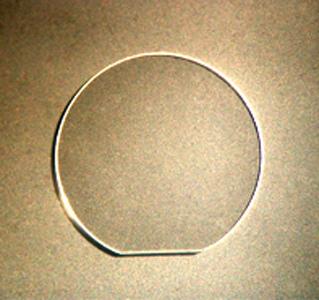
“You can make a bad crystal out of a good crystal blank, but you can’t make a good crystal out of a bad crystal blank.” This was ancient wisdom passed on to me from a veteran crystal engineer fifty years ago as I began to learn about crystal engineering, and it is as true today as it was then. Sometimes we get so caught up in all the important processes in the crystal finishing area – from baseplating to cleaning to epoxy-attach to final frequency adjustment through high- temperature burn-ins, and then sealing into ultra-clean hermetic packages. It’s easy to forget about the importance of the (too often underappreciated) crystal blank. That can be a big mistake. The blank, after careful preparation, becomes the actual quartz resonator. It’s usually a thin round wafer, but sometimes a thin rectangular wafer – lapped, etched and polished to the exact needed frequency.
From Quartz Bar to Blanks
The process of making quartz crystal blanks starts with growing quartz bars at high temperature and pressure from pure “seeds” and raw quartz “nutrient.” In general, the slower this process the better the finished quartz bars will be. After all, natural quartz has been cooked deep within the earth’s surface at high temperature and pressure for millions of years. For making high- reliability quartz crystals, bars with a minimum “Q” of 2.2 million are used. These quartz bars must then be precisely X-rayed to orient them properly with respect to the crystal axes. This allows for cutting the wafers (blanks) with the right angle to give the needed frequency-vs- temperature performance. (For a more detailed explanation, go to the previous XOProf.com post: “Unleashing the Mystery of Chrystal Cuts.”)
Preparing the Wafers
The individual blanks then need to be rounded (or turned into rectangles) without causing any edge flaws, cracks or chip outs. Then follows the lapping process. This is a series of mechanical grinding steps that must be performed to produce very smooth and parallel surfaces, while gradually making the wafers thinner until they reach precisely the required frequency (the frequency depends on the thickness of the wafer). After the extensive lapping process, the blanks are then chemically etched to produce a still finer surface finish. Finally, the blanks are mechanically polished until the blanks, which previously were opaque, are so smooth that they become perfectly transparent like fine glass.
A Good Crystal Oscillator Starts with a Good Blank
If the blank is not on the correct angle (with respect to the silicon dioxide molecular lattice) then the subsequent finished crystal unit can never be made to meet the frequency-vs- temperature specifications. If the surface finish of the blank is not “smooth” enough, with no uneven roughness and with almost perfect edges and flatness, then the phase noise, series resistance and frequency stability of a finished crystal made from it will suffer. The quartz crystal resonator blank is the heart of the precision quartz crystal unit.
So, it’s true. Unless rigorous adherence to the process is followed, a good blank can end up as a bad crystal, but starting with a bad blank will never produce a good crystal.